
page 4
john cribbs
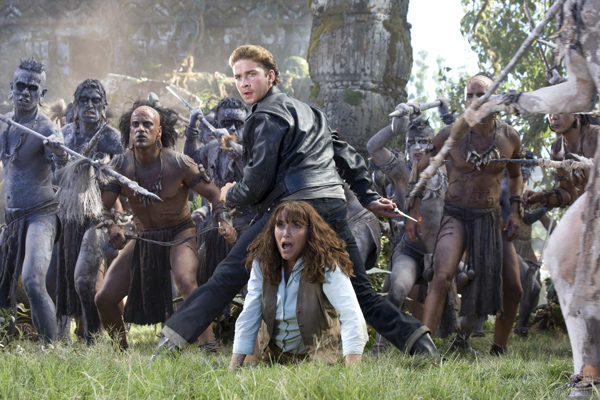
There's a lot to be said for Indiana Jones going solo. The reason Raiders works so well is that every action is one that Indy is motivated towards: get the headpiece, save Marion, save Marion again, find the Ark, retrieve the Ark, save Marion a third time. Last Crusade follows the same structure with Henry Sr standing in for Marion, and Temple of Doom comes up short largely because there are too many instances of the other characters saving Indy, and Indy taking a backseat to Short Round driving the car or the mine cart. In the motorcycle scene Indy literally takes a backseat and kind of remains there for the rest of the movie. I was actually surprised at Shia LeBeouf in this - he does a decent enough job and has working chemistry with Ford. But the need for his character is unclear. The idea that Indy is lonely is fainted touched upon when he announces to the audience that his father is dead (I guess the immortal life gimmick that came with drinking from the grail was bullshit.) It's also revealed that Marcus Brody has died, an unnecessary addition considering a moment later in the film where a statue in Brody's likeness plays a part at the end of the motorcycle chase sequence would have been a more than adequate homage to the late Delholm Elliott (also, Elliott being dead and Connery just not being in the movie makes that moment weird.) I've noticed the line "We seem to have reached the age where life stops giving us things and starts taking them away" significantly attributed to Indy in several articles and reviews, but it's actually Broadbent's character who says it off-handedly...I just didn't buy this half-hearted attempt to make Indiana's age play a factor in the screenplay and justify giving him a spunky, adventurous son. By the end of the film, Indy is running around with a record four people in tow (appropriately I guess, he's gained one per movie...really, he's lonely?) and allows them to do most of the work: Marion drives, Ox exposits, Mac winces and Mutt does pretty much all the stuff Indy used to do. Even when he had a big team with him in Last Crusade, at the end of the film he's facing the final challenges alone. Here I don't think he plays any significant role for the last 30 minutes of the movie, but I'll come back to that in a minute.
Mutt and Indy find clues left by Ox at an insane asylum in the best designed and best looking sequence of the film - Janusz Kaminski actually does a great job replicating the cinematography of Douglas Slocombe throughout the movie. It must have been humbling for him, considering his work is usually so...what's the industry term for "crappy?" Oh yeah - stylized. Anyway, the clues lead them to the underground passages of an ancient graveyard, which once again serves to remind us of a major moment from the past films, the very first sequence from Raiders, the entrance into the ruins and Indy's hot footing it with a giant goddamn boulder at his heels. Monkey men stand in for the Hovitos and big scorpions replace giant tarantulas (I liked the line about not worrying about big scorpions pinching you, but it didn't go anywhere) and Indy warns Mutt "Don't touch anything!" so we can all nod and think, 'Oh we know!' But there are no real traps or sinister devices here, the whole thing is such a cake walk it seems like they should have just sent Jim Broadbent to collect the skull. But they find it themselves, and that leads me to the worst thing in the movie. Indy and Mutt find a big HR Giger-looking alien head among the old tombstones which, I came to understand about 10 minutes later, was the famous Crystal Skull of the title. I thought it was some kind of clue to lead to the skull, but it turns out this tacky, plastic thing with saran wrap inside is the very thing they were looking for.
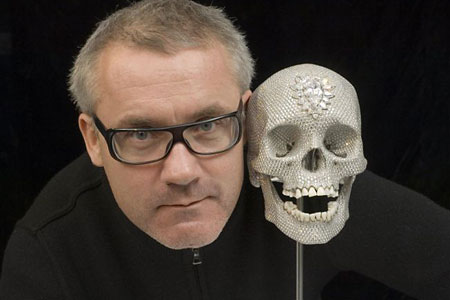 It is impossible to overstate the importance of props in the early Indy movies. The golden Peruvian idol from the beginning of Raiders, the Ark, the Shankara stones, the grail diary - even the nondescript grail itself - are so incredible looking and considered with such awe by the actors that their mere presence onscreen was enough to translate their paramountcy to the audience (pun intended.) The skull looks like something a lame goth kid would have on his dresser. I thought it was a flaurescent lamp. Or a cheap Halloween decoration. Indy's first word upon seeing it - "unbelievable" - was more right than he knew. I didn't believe its power for a second. Nobody in the movie seemed genuinely impressed with it either; I kept forgetting the characters had it until it was pulled out from under a cloth or inside a satchel. It made Damien Hirst's crystal skull seem like, well, a work of art (and yes my wife pointed out the specific Hirst joke earlier in the movie.) It may well be the stupiest looking macguffin of all time: if the Maltese Falcon is what dreams are made of, the Crystal Skull must be what the top of the Spencer's Gifts novelty clearance sale table is made of. The artifact that shares Indiana Jones' name on the marquee needs to be just as much a character as he is - it needs weight, needs to breathe. And even though a skull is directly linked to breathing, this thing was dead on arrival.
It is impossible to overstate the importance of props in the early Indy movies. The golden Peruvian idol from the beginning of Raiders, the Ark, the Shankara stones, the grail diary - even the nondescript grail itself - are so incredible looking and considered with such awe by the actors that their mere presence onscreen was enough to translate their paramountcy to the audience (pun intended.) The skull looks like something a lame goth kid would have on his dresser. I thought it was a flaurescent lamp. Or a cheap Halloween decoration. Indy's first word upon seeing it - "unbelievable" - was more right than he knew. I didn't believe its power for a second. Nobody in the movie seemed genuinely impressed with it either; I kept forgetting the characters had it until it was pulled out from under a cloth or inside a satchel. It made Damien Hirst's crystal skull seem like, well, a work of art (and yes my wife pointed out the specific Hirst joke earlier in the movie.) It may well be the stupiest looking macguffin of all time: if the Maltese Falcon is what dreams are made of, the Crystal Skull must be what the top of the Spencer's Gifts novelty clearance sale table is made of. The artifact that shares Indiana Jones' name on the marquee needs to be just as much a character as he is - it needs weight, needs to breathe. And even though a skull is directly linked to breathing, this thing was dead on arrival.
You know what else should have felt like a character? Indiana Jones. So far I've complained that Indy hasn't changed enough (he's older but that fact isn't worked into his personality), he lacks motivation to move from one action scene to another, and that he starts to take a backseat when the action starts up in the second half of the movie. I don't know if it's because he seems so less involved with the things happening in the movie, but on top of not changing enough he's also lost a bit of what we recognize as Indiana Jones. My concerns over the Koepp script (which I understand is drawn from numerous other drafts by different writers, but at the end of the day itís his name on the screen) were mainly confirmed in this area. For one thing, he has Indy using a new batch of tender nicknames - "sister," "babe," "hon" - that turn him into quite the softie and lack the sarcastic sting of "sweetheart," which he used to mock Willie Scott. I don't have much to say about Harrison Ford's performance beyond saying that it's adequate overall and certainly better than anything he's done since The Fugitive, but he's given so little of his former hero to play I'm not even sure if I remember a good old Indy grin making its way into the movie. He doesn't come off as a romantic (he has a skeezy line about having a lot of girlfriends) or as the scarred veteran of numerous life-threatening situations. As Marcus Brody once got lost in his own museum, it feels like Indy gets lost in his own movie, no longer the James Bond in his own James Bond adventure (if it seems like I'm bringing up the Bond movies a lot, I'll remind you that Raiders came out of Spielberg's interest in making a Bond film.) The supporting characters don't offer much: Mutt asking Spalko to hold on so he can comb his hair before she kills him is actually the best character moment in the entire movie. The script is full of other weird inconsistencies (why is Mutt introduced calling Indy "professor," then seem surprised later when he finds out heís a teacher? And after he's already seen him in action against the first set of natives, why does he still doubt his abilities and label him "some school teacher?") and never focuses on any character, especially not its main one, long enough to shape their personalities beyond their rudimentary function in the story.
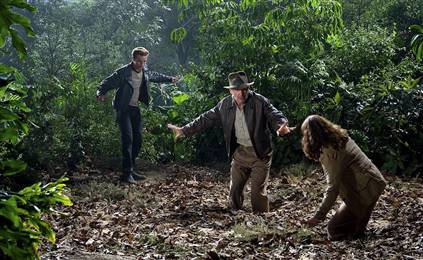 Which leads me to the one moment of character connection that I liked a lot. I won't lie: it was terrific seeing Karen Allen return as Marion Ravenwood, the hard-drinking, monkey-trusting, torch-wielding firecracker we all fell in love with in Raiders of the Lost Ark. She at least remembers what Marion's smile looks like and supplies the role with the same amount of charm as she did 30 years ago. In her first big scene the good guys escape from the Russians (by pushing them down and booking it, very inventive) and instantly run into a dry sand pit. This is the part of the film tha gave me some hope for these characters to be drawn out a bit more, as Indy and Marion, only just recently reunited, try to talk to each other as they're sinking. Indy can't help teaching, explaining the difference between quick sand and dry, then instantly becomes a dad when Marion reveals that he sired Mutt. I read somewhere that Lawrence Kasdan (who wrote Raiders, but also made Dreamcatcher) helped out with the scenes between Indy and Marion, and it's most evident in their amusing back-and-forth here. Everything about Indy that could have been established, and re-established, up to this point is present here: he's weathered and wise and impatient, he's so entangled in the moment that the danger of their predicament all but eludes him. I actually went back later to watch the scene again:
Which leads me to the one moment of character connection that I liked a lot. I won't lie: it was terrific seeing Karen Allen return as Marion Ravenwood, the hard-drinking, monkey-trusting, torch-wielding firecracker we all fell in love with in Raiders of the Lost Ark. She at least remembers what Marion's smile looks like and supplies the role with the same amount of charm as she did 30 years ago. In her first big scene the good guys escape from the Russians (by pushing them down and booking it, very inventive) and instantly run into a dry sand pit. This is the part of the film tha gave me some hope for these characters to be drawn out a bit more, as Indy and Marion, only just recently reunited, try to talk to each other as they're sinking. Indy can't help teaching, explaining the difference between quick sand and dry, then instantly becomes a dad when Marion reveals that he sired Mutt. I read somewhere that Lawrence Kasdan (who wrote Raiders, but also made Dreamcatcher) helped out with the scenes between Indy and Marion, and it's most evident in their amusing back-and-forth here. Everything about Indy that could have been established, and re-established, up to this point is present here: he's weathered and wise and impatient, he's so entangled in the moment that the danger of their predicament all but eludes him. I actually went back later to watch the scene again:
Marion: Mutt can be a little impetuous.
Indy: Well, it's not the worse quality in the world. Keep your arms above the surface - when the kid comes back, grab on.
Marion: Indy, he...
Indy: He's a good kid, Marion. You should get off his back about school.
Marion: Mutt, I mean...
Indy: Not everybody is cut out for it.
Marion: His name is Henry!
Indy: (nods) Henry. Good name.
Marion: He's your son!
Indy: ...My son?
Marion: Henry Jones the Third.
Indy: (beat) Why the hell didn't you make him finish school?
Maybe there's just too much going on the movie up to this point and the dry sand pit thankfully slowed it down long enough to allow this moment to happen. The snake/rope gag that ends the scene is inspired, and handled with an unforced knowingness and humor that all the film's in-jokes and references should have taken note of.
Of course Karen Allen's presence in the film comes with the gorgeous "Marion's Theme," and this is probably the area where not seeing the movie in a theater was a real disadvantage because I honestly can't remember anything about the new score at all. In the spirit of nostalgia, John Williams brings back lots of selections from Raiders, the "Raiders March (Indiana Jones Theme)" is played perpetually with little or no variation, but if there was a new "Crystal Skull Overture" it must have been drowned out by the rest of the movie. It was another big disappointment, as all three films of the trilogy have such a specific soundtrack that makes them instantly discernible from each other as well as any other film unfortunate enough not to be graced with a Williams-in-his-prime score. His new music for Crystal Skull was one of the things I was looking forward to without anxiety, and it seems to have passed by completely unnoticed like the two Nazi soldiers who actually don't escape the wrath of the Ark - you just thought they did until you finally saw the movie again in its proper format.
As much as defenders of Crystal Skull like to use the ridiculous moment from Temple of Doom with the liferaft falling from the plane as an example of something even more ludacris than the things that happen in this movie, I always thought of that scene as an incredible transition into three separate action sequences: the plane crashing, the raft flying down the snowy hill, and ultimately ending up in the rapids: air, land and sea. And I hate to disagree with Paul Cooney, but more often than not plausibility does not overrule excitement and innovation. In the movie's big, all-out action set piece, Crystal Skull goes for the same thing, only stretched over a much longer running time and not successful from beginning to end. At this point the movie has had character problems, unexceptional music and way too many references to the original trilogy, but it has not failed to jump into its action scenes with full relish and the intent to entertain. The same goes for the "jungle chase" sequence, but weirdly a major ball is dropped almost instantly. In the trilogy, action sequences are beautifully set up: "Truck - what truck?!" "Great, more boats." Here, just before things get nuts, Spielberg introduces a giant treader with two arms holding impossibly gigantic saws which mow down the jungle as if it wasn't there to make a path for the Russian convoy. I had seen the Lego toy version of this beast, and the minute it appeared in the movie my mind went wild imagining how it was going to be used in the upcoming action scene. Like the plane in Raiders, no doubt, with characters running over it and under it punching and shooting at each other trying to avoid the perilous blades!
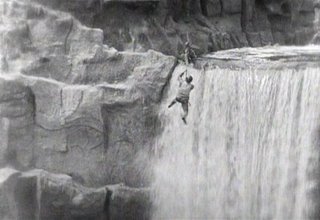 My heart sank when it turned out the vehicle was used for nothing more than to be bazooka'd, one of the loose blades chopping up a few trucks before flying harmless away from the characters. What's the point of introducing a behemoth like that if they're just going to blow it up right away? It couldn't be the practical purpose of creating a read for the following vehicles, since there are suddenly roads all over the jungle once the chase begins. And while we're at it, what's the point of going down three progressively larger waterfalls if each plummet produces the same flaccid pay-off of the characters shrugging it off, three non-threats in a row? In the much-hated Temple of Doom, a stationary rolling grinder was made deadly by the believable stunt choregraphy and Harrison Ford's performance: you were made to think that Indy could conceivablly die. Here it's a wasted wink at the audience: when has a waterfall ever killed a movie character, much less Ford who even survived one in the more-realistic Fugitive? It's funny that people attack the 'fridge nuking scene when this sequence of waterfalls doesn't even pretend to be thrilling or dangerous, just slapsticking and glib - a real smack in the face to classic scenes like Buster Keaton over the waterfall in Our Hospitality.
My heart sank when it turned out the vehicle was used for nothing more than to be bazooka'd, one of the loose blades chopping up a few trucks before flying harmless away from the characters. What's the point of introducing a behemoth like that if they're just going to blow it up right away? It couldn't be the practical purpose of creating a read for the following vehicles, since there are suddenly roads all over the jungle once the chase begins. And while we're at it, what's the point of going down three progressively larger waterfalls if each plummet produces the same flaccid pay-off of the characters shrugging it off, three non-threats in a row? In the much-hated Temple of Doom, a stationary rolling grinder was made deadly by the believable stunt choregraphy and Harrison Ford's performance: you were made to think that Indy could conceivablly die. Here it's a wasted wink at the audience: when has a waterfall ever killed a movie character, much less Ford who even survived one in the more-realistic Fugitive? It's funny that people attack the 'fridge nuking scene when this sequence of waterfalls doesn't even pretend to be thrilling or dangerous, just slapsticking and glib - a real smack in the face to classic scenes like Buster Keaton over the waterfall in Our Hospitality.
But I'm getting ahead of myself. I'm supposed to talk about the Tarzan scene now, right? The fridge nuking scene's redheaded stepchild? Whatever, it made sense to me: in Raiders the monkey was a Nazi double agent, here there is an army of monkeys apparently sympathetic to the good guys. The effect of Mutt swinging on the vines looked terrible and the idea is an unapologetically goofy one, but I knew in my heart that I had seen even more unforgiveably dumb moments in other movies before the scene was over. It's certainly no better or worse than the jeep-to-jeep swordfight between Mutt and Irina. The monkeys were better than the ants, who simply didn't look or behave right and posed too immediate a threat (although they clearly hated the Crystal Skull as much as I did.) The "giant vampire bats" from Temple of Doom were intimidating in presence alone, but all the ants did was remind me of the man-eating beetles in the Mummy movies (and yeah, I know they are supposed to be a homage to the scene from Naked Jungle, just like the sand coming from the stone is a lift from Land of the Pharaohs.) Speaking of Stephen Sommers' Speilberg knock-off, at the end Mac becomes too much like the Kevin J Anderson character from The Mummy, stuffing gold into his pockets and paying the price for loitering in the crumbling kingdom (even Alfred Molina in Raiders didn't stick around once the walls started collapsing around them.) Things like that made me realize that an Indiana Jones movie 20 years later is inevitably going to seem derivative of the trilogy's imitators, and besides the lost city of gold being the target of the mid-80's IJ rip-off Allan Quatermain and the Lost City of Gold* as well as National Treasure 2, the action and comedy of something like Shanghai Noon or better-explained mythology and more fleshed-out archaleogist characters of the Hellboy movies seem to have informed a lot of the decisions made in this fourth film: a messy omelet made from the egg that came before the chicken.
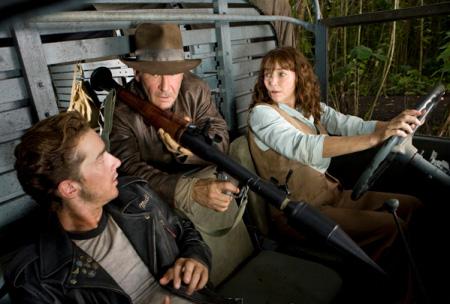 So I had mixed thoughts about the epic and ambitious jeep chase/swordfight/Tarzan swinging/ant invasion/waterfall dipping action sequence that made up the core of the second half of the movie. I'd like to see it again and determine which parts worked better than others (I did enjoy Marion taking the duck over the cliff onto the tree and the giant branch snapping back to knock Russian pursuers off the side of the mountain), but from my memory there was something off about each level of the building climax. After they've dried off from the inconvenient waterfalls, the heroes meet yet another group of un-aboriginal warriors. I always thought the opening of Raiders with its spear-toting "ooga booga" primitives was a quick way to acknowledge that, yes, this is a homage to the classic serials of the 30's and 40's, but we're taking care of it right here and shan't be returning to this sort of thing. The ending of Crystal Skull with its Mayan temple and lost treasure and second batch of irritable tribesmen is full-on self indulgent "this is where Indiana Jones comes from and the thing of thing that people think he should be up to." By the time Indy and company enter the final temple to return the plastic prop to the Close Encounters/A.I. alien/robot thingies and wrap this thing up, I admit I was a little overwhelmed by the sheer amount of bombast of action that leads to the final scenes and had a hard time remembering where it was they were going and what they were supposed to do. I think the filmmakers were aware of that, and figured as long as there were vines and stone tablets and good guys and bad guys running around the inside of a big jungle set people would understand that this was the big finale of an Indiana Jones movie. Like I said, I'd like to watch the final reel again and try to follow things a little better - the first viewing is kind of a blur.
So I had mixed thoughts about the epic and ambitious jeep chase/swordfight/Tarzan swinging/ant invasion/waterfall dipping action sequence that made up the core of the second half of the movie. I'd like to see it again and determine which parts worked better than others (I did enjoy Marion taking the duck over the cliff onto the tree and the giant branch snapping back to knock Russian pursuers off the side of the mountain), but from my memory there was something off about each level of the building climax. After they've dried off from the inconvenient waterfalls, the heroes meet yet another group of un-aboriginal warriors. I always thought the opening of Raiders with its spear-toting "ooga booga" primitives was a quick way to acknowledge that, yes, this is a homage to the classic serials of the 30's and 40's, but we're taking care of it right here and shan't be returning to this sort of thing. The ending of Crystal Skull with its Mayan temple and lost treasure and second batch of irritable tribesmen is full-on self indulgent "this is where Indiana Jones comes from and the thing of thing that people think he should be up to." By the time Indy and company enter the final temple to return the plastic prop to the Close Encounters/A.I. alien/robot thingies and wrap this thing up, I admit I was a little overwhelmed by the sheer amount of bombast of action that leads to the final scenes and had a hard time remembering where it was they were going and what they were supposed to do. I think the filmmakers were aware of that, and figured as long as there were vines and stone tablets and good guys and bad guys running around the inside of a big jungle set people would understand that this was the big finale of an Indiana Jones movie. Like I said, I'd like to watch the final reel again and try to follow things a little better - the first viewing is kind of a blur.
While I actually thought the interdimensional aliens were a neat idea and dug the realization that "knowledge was their treasure," this is a lot to be revealed and taken in during the last five minutes of the movie. In the end it's the artifact itself and the villain's desire to use it for evil that destroys Spalko, who pays the same heavy price as Bellocq, Mola Ram, Donovan and Elsa before her. But what does Indy get out of this adventure? In Temple of Doom he realizes that he's a hero who will do the right thing when faced with a decision, he's not a fortune seeker. In Last Crusade he repairs his lifelong bad relationship with his father, in Raiders he realizes the girl is more important to him than the ancient, all-powerful Ark. Although Mutt seems to like Indy better and Marion and Indy get hitched, the dry sand scene and a quick dialogue filler in the back of a truck are the only moments the three of them even have together where they aren't dueling at 50 mph, swinging with the monkeys or firing rocket launchers. Any connection between them the audience was meant to glean seems to have disappeared into "the space between spaces" along with the aliens. It's a weak script, and that has nothing to do with it being an Indiana Jones movie made 20 years down the line.
It may not seem like it, but I'm really glad I saw this movie. Honestly. There are a lot of things wrong with the film overall, and it's a good thing I didn't see it when it first came out or I most likely would have been harder on it, but I consider this one of Spielberg's flawed masterpieces along the lines of War of the Worlds and Munich - it's probably his 7th or 8th best movie, depending on how you feel about Empire of the Sun. Am I ready to accept it as a part of the Indiana Jones saga? Sure - but not part of the original trilogy. And I'm not excluding it out of snobbish stubborness, it's just not as good as those movies, not even Temple of Doom. If it had made more of an effort to be its own adventure and hit the right Indy notes rather than slamming down on the keyboard to get attention I think it would have been better. The plot is interesting, the characters had potential, and some of Spielberg's skill as a deft action director is still apparent but it just doesn't work as well. The best thing I can say about it is that it at least belongs in the same universe, and unlike the Star Wars prequels it feels like they made an effort to keep it there.
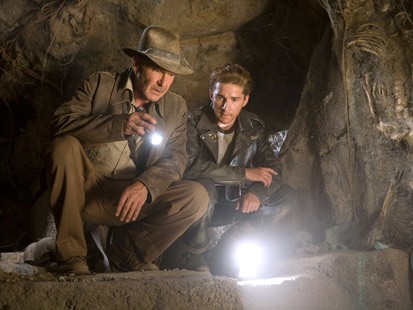 Something I'm really curious about is why the film received a PG-13 rating. There's not a scary or moment that could be considered morally objectionable in the entire movie. Remember how Temple of Doom invented the PG-13 with that grisly unconsented heart removal sequence? One way I measure the trilogy's generational impact on my family is by remembering how my dad covered my eyes when the bad guys melted at the end of Raiders, covered my brother's eyes during the heart scene in Temple of Doom, and covered my sister's eyes when Donovan mummifies and explodes after drinking from the wrong cup in Last Crusade. I have a child now, who is like a son to me except she happens to be of the girl persuasion and is therefore my daughter. I guess at the end of the day I want a movie with a scary part that I can shield her eyes from (other than a phony-looking prop.) In a way that's another reason I was against them making an additional Indy movie so late in the game - I want there to be an Indiana Jones movie for her generation, and if the binds of childhood nostalgia and a geek-run Hollywood keep demanding things like Star Wars prequels and a new Indiana Jones trilogy and remakes of every John Carpenter film then nothing original and new will get made. I can already see myself as the fuddy duddy daddy who dusts off his copy of Gremlins and chases his daughter and her friends around insisting that they sit down and watch this RIGHT NOW, it will change their little worlds! But honestly I'd rather have her discover her own movie magic, and be there to appreciate it with her like my dad did with me. Past nostalgia is truly threatening future nostalgia.
Something I'm really curious about is why the film received a PG-13 rating. There's not a scary or moment that could be considered morally objectionable in the entire movie. Remember how Temple of Doom invented the PG-13 with that grisly unconsented heart removal sequence? One way I measure the trilogy's generational impact on my family is by remembering how my dad covered my eyes when the bad guys melted at the end of Raiders, covered my brother's eyes during the heart scene in Temple of Doom, and covered my sister's eyes when Donovan mummifies and explodes after drinking from the wrong cup in Last Crusade. I have a child now, who is like a son to me except she happens to be of the girl persuasion and is therefore my daughter. I guess at the end of the day I want a movie with a scary part that I can shield her eyes from (other than a phony-looking prop.) In a way that's another reason I was against them making an additional Indy movie so late in the game - I want there to be an Indiana Jones movie for her generation, and if the binds of childhood nostalgia and a geek-run Hollywood keep demanding things like Star Wars prequels and a new Indiana Jones trilogy and remakes of every John Carpenter film then nothing original and new will get made. I can already see myself as the fuddy duddy daddy who dusts off his copy of Gremlins and chases his daughter and her friends around insisting that they sit down and watch this RIGHT NOW, it will change their little worlds! But honestly I'd rather have her discover her own movie magic, and be there to appreciate it with her like my dad did with me. Past nostalgia is truly threatening future nostalgia.
So there you have it, Funderburg. You bullied me into seeing it. I didn't love it, I didn't hate it, but my review steered closer to the nit-picky nerd side of the tracks than the mantra-chanting "it's fine, everything is fine" impartiality I was hoping for. Did I nuke the 'fridge of your measuring stick? Are we breaking up? If so, and we're dividing up the site in the divorce, I'll take this article/review and keep it as an example of how I was right all along and just should have stayed away, even though I'm glad I didn't. Time to ride into the sunset...
And just in case we do come to an amiable agreement to keep the site up, in the spirit of long-delayed entries to a beloved series, next week I'll be unleashing an article that's way overdue. I won't say what it is, I'll only ask: "What power should a man possess to challenge the prince of darkness?"
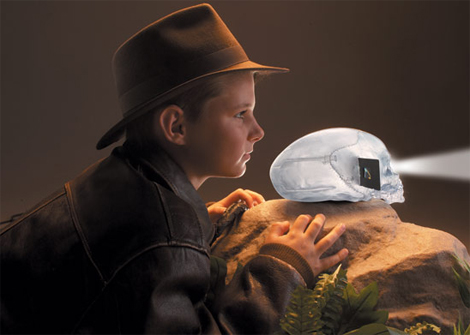
APPENDIX
Skull-Lovers: Roger Ebert, Chris Funderburg, Harry Knowles, Claudia Puig, Richard Roeper, Jonathan Rosenbaum, Lisa Schwarzbaum, Kenneth Turan, Vern
Skull-Haters: James Berardinelli, Ellen Cribbs, David Denby, Trey Parker, Rex Reed, Peter Travers, Matt Stone
Skull-Inbetweeners: John Cribbs, Drew McWeeney, Jonathan Rosenbaum
*And yes, I know that the literary Allan Quartermain was a template for the Indiana Jones character, but the 80's Allan Quartermain movies just copied the Spielberg formula: it was one of those UK "Coupling"-begat-"Friends"-begat-shitty-US "Coupling" deals.
<<Previous Page 1 2 3 4 Next Page>>
home about contact us featured writings years in review film productions
All rights reserved The Pink Smoke © 2010